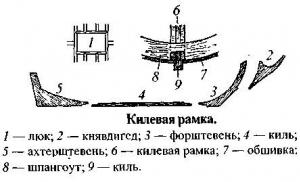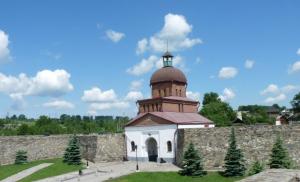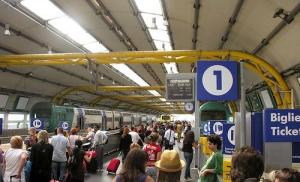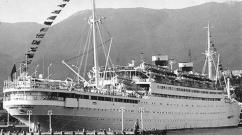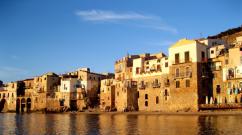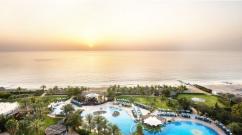Papua new guinea island indonesia. Photo report Papua, Indonesia
I open my LiveJournal with a post about one of my most unforgettable travels, because this is exactly the side I want you to recognize me: open, a little adventurous, sincere and courageous. This is my first post, so don't judge too harshly!
In the summer of 2010, my boyfriend invited me to take what he called the most unforgettable trip of my life. And since I was busy with moving and other organizational troubles during this period, I trusted his persuasion to leave the choice and organization of the trip to him. Yes, of course, in the process of preparation, I found out that we were going to Indonesia, and that the format of our vacation would be active and involve hiking conditions.
And only an uncertain bell of understanding rang in my head after I saw with what care he collected a first aid kit, packed matches and a satellite phone.
Well, the backpacks are packed, air mattresses, T-shirts, quick-drying towels are packed, suitable shoes are purchased.
An adventure lies ahead... After a long flight with 4 transfers, we finally reached Wamena in Indonesia. Airport: barracks buildings and one landing strip. On the plane, just before boarding, I was given an introductory course on the history and geography of the region.
New Guinia is the second largest island in the world, after Greenland. It is located in Oceania, more precisely in the southwest Pacific Ocean. The island is almost equally divided between two countries: Indonesia and Papua New Guinea. According to one theory, this is one of the first sites of human migration from Africa, which occurred more than 40,000 years ago.
Despite the fact that the island was discovered by Spanish discoverers back in the 16th century, due to the fact that a huge part of the island is impenetrable jungle, some of its parts remain poorly studied.
During World War II, the island was occupied by the Japanese. By the way, the Papuans, rejected by the atrocities of the Japanese army, showed themselves a lot in helping the allies, fighting alongside Australian soldiers, transporting equipment and the wounded across the entire island.
The region we were planning to visit was discovered by chance during this period. An American military plane crashed in the jungle of the island. The surviving soldiers were surprised when they found themselves visiting a tribe whose existence no one had previously known.
These were people whose development corresponded to the development of humanity in the prehistoric period. These small tribes subsisted primarily on the meat of dead animals and collecting wild plants. Their tools and weapons were made mainly of stone and wood.
We were able to see representatives of three tribes: Dani, Lani, and Yali.
And they looked like this:

//dariamontreal.livejournal.com
To see them, we first drove for several hours from Wamena, and then, equipped with backpacks, we went on a three-week walking tour. We either slept in huts kindly offered to us by the tribal leaders, or pitched a tent.

//dariamontreal.livejournal.com

//dariamontreal.livejournal.com
After the Second World War, missionaries, if I’m not mistaken, American and Australian, began to come to Papua Indonesia with the goal of civilizing the local residents and, of course, for religious purposes. During this period they built a number of schools. Unfortunately, they are all empty now. You can also thank the missionaries for the imported sweet potatoes, from the cultivation of which the majority of the population now lives.

//dariamontreal.livejournal.com
The tribes of Papua are polygamous. Women in the family do all the hard work: build huts, raise children, grow potatoes, look after wild pigs, carry water, cook, etc. The role of a man in the family is to reflect. And also, in the event of a war between tribes, to defend their territory. By the way, most often, feuds between tribes occur over stolen piglets or women.
From our trip, we brought various arrows as a souvenir. There are more than a dozen types of them: for piglets, for birds, for fish, separate ones for the enemy, for an unfaithful wife...

//dariamontreal.livejournal.com

//dariamontreal.livejournal.com

//dariamontreal.livejournal.com
The island is home to wide biodiversity.
On the island you can see from 5 to 10 percent of all biological species of the planet, a huge number of endemic species - those that can be found only on this island and nowhere else, thousands of species are still unknown to scientists, more than 200,000 species of insects are supposedly undiscovered, about 20,000 plants, more than 650 species of birds.

//dariamontreal.livejournal.com
- Cases of religious and ritual cannibalism are still recorded in this region.
- The Karawai tribes are known for building their huts in the branches of trees. This tribe was not known until 1970. But to see them, you will have to go for a month deep into the jungle (or organize a special helicopter flight, but the difficulty is that it is almost impossible for a helicopter to land in the jungle.)
- Since 2003, the authorities of Inodenza have prohibited the entry of journalists into the tribal areas for work-related journalistic purposes.
- In May 2006, tourist guide Paul Raffaele, who hosted the crew for the Australian TV show 60 Minutes, was allegedly approached by a tribal member who claimed that his 6-year-old nephew, Wa-Wa, had been accused of in that he helps evil spirits (he heals witches). According to local rituals, the boy must become a victim of cannibalism. For obvious reasons, the 60 Minutes team refused to help them. But Paul Raphael found support in another television company, which agreed to send a team to save the boy. Unfortunately, the entire group was deported from the country by the Indonesian authorities before they even reached the tribe (officially due to visa problems). No more information is known about the boy's fate.
And another photo

//dariamontreal.livejournal.com

//dariamontreal.livejournal.com

//dariamontreal.livejournal.com

The island of New Guinea is divided by an almost perfectly flat border stretching along longitude. To the west of the border is Papua, one of Indonesia's two autonomous provinces.
The Indonesian Autonomous Province of Papua has a lot of everything: it is the largest in area among the provinces of Indonesia, it is also the most diverse in national composition, and it also has the most difficult terrain compared to other regions of this island country. Noteworthy are the differences in altitude - from snow-capped mountains with a maximum height of almost 5000 m to coastal lowlands overgrown with rain forests, with patches of savannas and swamps.
This complex landscape makes it difficult to communicate between different areas of Papua. And this also explains the extremely diverse ethnic picture: individual tribes can live just a few kilometers apart from each other, but never communicate for thousands of years.
The only transport routes in such conditions are rivers, especially the Digul River, which is navigable to the very headwaters of the Jayawijaya Mountains, one of the ridges of the Maoke Mountains. The distance from the source to the mouth in a straight line is relatively small, but the river flows through a swampy lowland in a very winding channel.
The vegetation of the province is tropical rainforests, once dense and tall, but noticeably thinned out as a result of merciless deforestation.
Despite the gradual decline in forest area, Papua's fauna still retains diversity and is known for endemic species, mainly birds, of which there are about 100 species. All of them are endangered due to loss of natural habitat. In addition to the world-famous great bird of paradise, such bizarre birds as the black-winged red loris, Schlegel's woodpecker, Biak bigfoot, fruit pigeon, fruit dove, Biak cuckoo, and Riedel's paradise kingfisher live here.
To preserve Papua's endangered wildlife, Lorenz National Park was established as the largest protected area in Southeast Asia. There is also Vasur National Park, which is predominantly savanna but also includes wetlands.
During the era of great geographical discoveries, the Spaniards were the first to see these lands in the first half of the 16th century. Subsequently, the territories became part of the Netherlands East Indies as Netherlands New Guinea. During World War II, Papua was captured by the Japanese, who established a large supply base for their troops in the Pacific theater of operations. At the end of the war, the island was stormed by American Marines, who encountered fierce resistance and well-established Japanese defense. At the cost of considerable losses, Papua was liberated. After the war and until 1961, Papua remained a Dutch possession until Indonesia's independence was declared in 1945 and it was occupied by the Indonesian army in 1961 and subsequently absorbed as part of it in 1969. West Irian region. In 2002, it received the name Papua.
Papua is the largest and easternmost province of Indonesia. Its territory is dominated by a mountainous landscape, the largest peaks are crowned with glaciers that are melting due to climate change. The north and south of the province are occupied by lowlands. The Mamberamo River, the largest in Papua, flows through the northern region.
Papuans have been fighting for the independence of their region for several decades, demanding independence for the region. The Papuans are not happy with the current “broad autonomy”.
Rough terrain has long hampered exploration of Papua. Thus, most of the territory of Jayawijaya District is occupied by the densely populated Baliem Valley, and it was discovered and explored by Europeans only in the 1940s.
The province has a strikingly diverse ethnic picture: it is home to many Papuan and Austronesian peoples. For many of them, Indonesian has never become a lingua franca and they prefer to use one or more of the 269 local languages and dialects.
To avoid being confused with the Papuans, other residents of the province came up with the self-name “Papuans.”
Until recently, local tribes, in particular the Marindanim and Asmats, became known as cannibals and headhunters. In their communal “long houses” they collected thousands of enemy heads, which were considered a concentration of manna - magical power. The participation of all men of the tribe in headhunting was considered a manifestation of courage and military valor. Nowadays, this ritual is practiced extremely rarely: first the Dutch colonialists, and then the Indonesian authorities outlawed it and severely persecuted it.
But the authorities strongly support such Papuan traditions as “uor” (the ceremony of the first cutting of hair and the initiation of young men), the Josim Pankar friendship dance, which lasts all night long to the accompaniment of stringed instruments made from the roots of a coconut tree. The original festival on Lake Sentani is known all over the world - the largest in Papua - the key events of which are the “isilo” dance performed on boats and boat races with male and female crews.
The province has extremely tense interethnic relations: the indigenous Papuan population is unhappy with the fact that many Indonesians from other regions of the country have moved to the province in recent years. Against the backdrop of mass unemployment, people are attracted to work at numerous mining enterprises: Papua is very rich in minerals, and is home to one of the world's largest high-altitude quarries, the Grasberg, where gold, silver and copper are mined. The Papuans' dissatisfaction, from their point of view, is caused by the arrogant attitude of the new settlers towards the local culture, which they consider primitive and backward. Papuans are also unhappy that their homeland, as they believe, is a colony of Indonesia. They create fighting groups - scattered, poorly organized and poorly armed - and try to fight for the independence of Papua from Indonesia.
The provincial capital is called Jayapura, which means "glorious" or "victorious" in Indonesian. Activists of the national Papuan movement for provincial independence do not like the name. The Indonesian authorities have decided to reduce the intensity and are currently deciding on its replacement with Port Numbai. A dual situation has arisen: official documents retain the name Jayapura, while the local population uses the name Port Numbai, which has become a symbol of the struggle for independence from Indonesia.

General information
Location: west of the island of New Guinea. Autonomous province of Indonesia.Administrative division: 28 districts (kabupaten) and one city municipality (kota).
Administrative center: Jayapura city (Port Numbai) - 233,859 people. (2010).
Languages: Indonesian, Papuan and Austronesian languages.
Ethnic composition: Papuans (Asmat, Kamoro, Amungme, Dani, Sempan, Nduga) and Melanesians - about 50%, others (Indonesians, Chinese, Bataks) - about 50% (2010).
Religions: Protestantism - 65.48%, Catholicism - 17.67%, Islam - 15.89%, others (Buddhism, Hinduism) - 0.96% (2010).
Currency: Indonesian rupiah.
Largest rivers: Mamberamo, Digul.
Large lake: Sentani.
Major airport: Jayapura Sentani Airport.
Numbers
Area: 319,036.05 km2.Population: 3,486,432 people (2014).
Population density: 10.92 people/km 2 .
Highest point: Mount Puncak Jaya (4884 m).
Climate and weather
Equatorial.Average annual temperature: +27°С.
Average annual precipitation: 2850 mm.
Relative humidity: 60-70%.
Economy
Minerals: gold, silver, copper.Industry: forestry (delivery and processing of valuable tree species), mining.
Agriculture: crop production (horticulture, horticulture - sweet potatoes), livestock production (sheep and goats).
Traditional crafts: wood products, plant fibers.
Service sector: tourism, trade, transport.
Attractions
■ Natural: Asmat swamps, Lorenz National Park, Mount Puncak Jaya, Vasur National Park, Yotefa Nature Reserve.■ Cultural: ethnographic village of Kurula, mummies of the Wamena region.
Curious facts
■ From 1910 to 1962, the administrative center of the province, the city of Jayapura (Port Numbai), was called Holland and was the capital of the district of the same name within the Netherlands East Indies.■ In the province of Papua, the easternmost city of Indonesia is located - Merauke, at the mouth of the Maro River, which flows into the Arafura Sea. There is a common saying in Indonesia "From Sabang to Merauke", which means "Across the country": Sabang on the island is the westernmost of the Indonesian cities.
■ The name of the Sarmi district in the province of Papua is an acronym formed during the period of the Dutch colonization of this territory from the first letters of the Papuan peoples living here: Sobei, Armati, Rumbuai, Manirem and Isirawa.
■ The insectivorous plant Nepenthes remarkable grows in the forests of Papua. Its hunting jug bag can reach a length of 35 cm and a width of 9 cm. The bright color of the jugs and the sweet nectar on the leaves attract not only insects, but also birds and some small mammals, which become prey for the insidious plant.
■ The 270m long Mamberamo River suspension rope bridge was one of the largest in Indonesia until it fell into the river in 2011.
■ Papuans of the Korowai tribe build houses (borders) on trees at a height of 6 to 30 m from tree bark and palm leaves, thus saving themselves from floods, arthropods, and snakes.
■ Mount Puncak Jaya in the Maoke massif with a height of 4884 m is the highest point in Oceania and the highest mountain in the world, located on an island. According to some reports, its true height is 5029 or 5030 m.
In the 1960s the mountain was named after Indonesian President Sukarno.
■ In 2006, by decision of the Ramsar Convention, Vasur National Park was recognized as a wetland of international importance.
■ The destruction of Papua's forests will accelerate global warming: 42 million hectares of forests absorb volumes of greenhouse gases comparable to the carbon dioxide emitted into the atmosphere by almost all of Europe.
■ Dani women wear short skirts woven from orchid fibers and straw.
In the summer of 2010, my boyfriend invited me to take what he called the most unforgettable trip of my life. And since I was busy with moving and other organizational troubles during this period, I trusted his persuasion to leave the choice and organization of the trip to him. Yes, of course, in the process of preparation, I found out that we were going to Indonesia, and that the format of our vacation would be active and involve hiking conditions.
And only an uncertain bell of understanding rang in my head after I saw with what care he collected a first aid kit, packed matches and a satellite phone.
Well, the backpacks are packed, air mattresses, T-shirts, quick-drying towels are packed, suitable shoes are purchased.
An adventure lies ahead... After a long flight with 4 transfers, we finally reached Wamena in Indonesia. Airport: barracks buildings and one landing strip. On the plane, just before boarding, I was given an introductory course on the history and geography of the region.
New Guinea is the second largest island in the world, after Greenland. It is located in Oceania, more precisely in the southwest Pacific Ocean. The island is almost equally divided between two countries: Indonesia and Papua New Guinea. According to one theory, this is one of the first sites of human migration from Africa, which occurred more than 40,000 years ago.
Despite the fact that the island was discovered by Spanish discoverers back in the 16th century, due to the fact that a huge part of the island is impenetrable jungle, some of its parts remain poorly studied.
During World War II, the island was occupied by the Japanese. By the way, the Papuans, rejected by the atrocities of the Japanese army, showed themselves a lot in helping the allies, fighting alongside Australian soldiers, transporting equipment and the wounded across the entire island.
The region we were planning to visit was discovered by chance during this period. An American military plane crashed in the jungle of the island. The surviving soldiers were surprised when they found themselves visiting a tribe whose existence no one had previously known.
These were people whose development corresponded to the development of humanity in the prehistoric period. These small tribes subsisted primarily on the meat of dead animals and collecting wild plants. Their tools and weapons were made mainly of stone and wood.
We were able to see representatives of three tribes: Dani, Lani, and Yali.
And they looked like this:

To see them, we first drove for several hours from Wamena, and then, equipped with backpacks, we went on a three-week walking tour. We either slept in huts kindly offered to us by the tribal leaders, or pitched a tent.


After the Second World War, missionaries, if I’m not mistaken, American and Australian, began to come to Papua Indonesia with the goal of civilizing the local residents and, of course, for religious purposes. During this period they built a number of schools. Unfortunately, they are all empty now. You can also thank the missionaries for the imported sweet potatoes, from the cultivation of which the majority of the population now lives.

The tribes of Papua are polygamous. Women in the family do all the hard work: build huts, raise children, grow potatoes, look after wild pigs, carry water, cook, etc. The role of a man in the family is to reflect. And also, in the event of a war between tribes, to defend their territory. By the way, most often, feuds between tribes occur over stolen piglets or women.
From our trip, we brought various arrows as a souvenir. There are more than a dozen types of them: for piglets, for birds, for fish, separate ones for the enemy, for an unfaithful wife...



The island is home to wide biodiversity.
On the island you can see from 5 to 10 percent of all biological species of the planet, a huge number of endemic species - those that can be found only on this island and nowhere else, thousands of species are still unknown to scientists, more than 200,000 species of insects are supposedly undiscovered, about 20,000 plants, more than 650 species of birds.

INTERESTING FACTS:
1) Cases of religious and ritual cannibalism are still recorded in this region.
2) The Karawai tribes are known for building their huts in the branches of trees. This tribe was not known until 1970. But to see them, you will have to go for a month deep into the jungle (or organize a special helicopter flight, but the difficulty is that it is almost impossible for a helicopter to land in the jungle.)
3) Since 2003, the authorities of Inodencia have prohibited the entry of journalists into the tribal territory for work-related journalistic purposes.
4) In May 2006, tourist guide Paul Raffaele, who led the crew of the Australian TV show 60 Minutes, was allegedly approached by one of the tribesmen who stated that his 6-year-old nephew Wa-Wa ) was accused of being a shaman (according to religious beliefs, a person endowed with special abilities to communicate with spirits and supernatural forces, entering an ecstatic state, and also to cure diseases (witch doctor)). According to local rituals, the boy must become a victim of cannibalism. For obvious reasons, the 60 Minutes team refused to help them.
But Paul Raphael found support in another television company, which agreed to send a team to save the boy. Unfortunately, the entire group was deported from the country by the Indonesian authorities before they even reached the tribe (officially due to visa problems). No more information is known about the boy's fate.
And another photo









Yes, I regard the experience of visiting this part of the Earth as unique and amazing. Unfortunately, civilization, slowly but surely, is reaching here, destroying local originality. Presumably, in 10 years, in terms of their culture and organization of life, the Papuans will be little different from modern people. But it's not too late to take a time machine and find yourself in the Stone Age!
HI ALL!

An exciting journey into the extraordinary tropical kingdom of our planet. Amazing culture, shocking color and traditions of the Papuan tribes.
Tour to the island of New Guinea
Tour dates in 2019-2020: on request.
The island of New Guinea is the second largest island in the world after Greenland, located in southeast Asia, washed by the Pacific Ocean from the south and the Indian Ocean from the north. The island is administratively divided into 2 parts: the western part belongs to Indonesia - Irian Jaya. The eastern part of the island is Papua New Guinea. The island is surrounded by many small islands scattered in the South Pacific Ocean. This region is Melanesia, which means "Black Isles". Perhaps by the color of the skin of the indigenous population, or perhaps by the color of the earth, covered with a layer of black volcanic ash.
Climate. The air temperature ranges from 26°C during the day to 12°C at night.
Population. The local population speaks more than 100 languages that are incomprehensible even to their neighbors. Many of them barely surpassed the level of the Stone Age. Some still practice cannibalism.
Flora and fauna. New Guinea has an amazingly diverse flora and fauna: 150 species of lizards, 30,000 species of bugs, 200 species of frogs, 800 species of snakes, including 17 species of sea snakes. Ferns, orchids and climbing plants form a living carpet here, intertwining with the overhanging rainforest canopy.
Irian Jaya
The capital of the province is Jaipur Jayapura. Population: 2 million people.
There is Sentani Lake 30 km from Jaipur. Surrounded by mountains on all sides, the lake can be seen from the window of an airplane or after several hours of trekking, making your way close to the shore of the lake. On Apayo Island, local artists still create paintings using tree bark as canvas and carvings in a distinctive style. This style includes images of lizards and snakes and uses paints derived from natural dyes.
The mountain ranges crossing the island have created flat surfaces in the form of deep valleys surrounded by inaccessible mountains, the tops of which are covered with eternal ice. Mangrove swamps and dense jungle make large parts of the island impassable and reliably isolate the people living here from the influence of the outside world. Due to its territorial fragmentation, this province is distinguished by an incredible diversity of peoples and cultures.

Baliem Valley
A visit to the Baliem Valley has become an integral part of tourist routes. The indigenous tribes of Papua live here: Dani, Lani and Yali.
Tribes of Dani - Dani
The Dani tribes in the south of the Baliem Valley are perhaps the most widespread and welcoming. Spending the night in a thatched shed listening to the soothing grunting of pigs may not be very comfortable, but it is certainly unforgettable. It is not difficult to identify the inhabitants of the Dani tribe: the entire male costume consists of “holim” (a specially prepared fruit in the form of a pod or pumpkin), which is put on the “male part of the body” and worn as a symbol of the native tribe and one’s own courage. A pig's tooth is threaded through the nostrils, and the body is decorated with war paint made of clay and fat. Women of the Dani tribe wear knee-length skirts and are considered witches, whose power and magic increase with age.

Tribes of Yali - Yali
The Yali tribes live in the east of the Baliem Valley. Yali men are easily recognized by their rattan skirt, under which there is a narrow “cholim” at a right angle.
Lani tribes
The Lani tribes wear a feather headdress. “Holim” is tied to the waist with a bright colored sash. Sometimes "cholim" is used to store money or tobacco.
Traditional weapons are bow and arrows. Arrows made from different materials are designed for different purposes. Made of bamboo - for pigs, trident - for fish, four-prong - for birds, made of wood or human bone.
Cannibal tribe - Korowai
The Korowai people in these places still live by their traditions and religions. In 1970, missionaries tried to introduce Christian culture to the Korowai tribe, but several of the missionaries were eaten (the tribe practiced cannibalism). Then the missionaries founded the nearby settlement of Yaniruma, which only became open to tourists in the 1980s. But since it takes several days to reach the tribe, the tribe still remains practically wild.

Adventure eco-tour "Journey through the Baliem Valley"
Tour duration: 5 days / 4 nights.
If desired, the tour can be combined with a beach holiday in Bali!
Program
1 day. Arrival (lunch - dinner)
In the morning, arrival from Bali to Sentani airport in Jaipur, meeting at the airport with a guide. Flight duration is 5 hours.
Onward flight to Wamena. Flight duration is 40 minutes.
Wamena is the main city of the Baliem mountain valley. The Neolithic era and modernity coexist here; this is the territory inhabited by the Dani and Yani tribes.
Transfer from the airport to the hotel, check-in at the hotel.
Visit to Napua hill and Sinatma village, trip to the city for lunch.
In Wesaput village, explore the suspension bridge, visit the local handicraft center and explore the surrounding area.
Return to the hotel for dinner and overnight stop.

Day 2. Walk to Wesaput village (breakfast - lunch - dinner)
Breakfast at the hotel.
Transfer by car to Sogokmo village in the south of Baliem Valley. The duration of the trip is 35 minutes.
Next begins a 4-5 hour walk to Wesaput, passing through the villages of the Dani tribes and their sweet potato gardens, and crossing the suspension bridge over the Baliem River. Along the way, you will see Aboriginal activities and enjoy the beauty of the landscape.
Lunch will be provided along the route.
Transfer to the hotel, dinner at the hotel or at your discretion.

Day 3. Jiwika and War Dance (breakfast - lunch - dinner)
Breakfast at the hotel.
30 minute drive to Jiwika in the north of Baliem Valley. Examination of the 250-year-old mummy of one of the tribal leaders.
A 10-minute walk to Anemoigi village where you can see the Dani Mock battle. Here you can imagine what prehistoric wars looked like. Each of the warriors stands out with their own decorations and weapons, as well as war face paint. In the past, a small problem could escalate into large tribal wars. Here you can see how this tribe makes fire and visit the suckling pig festival.
Cooking pig the traditional way in hot stones with vegetables and sweet potatoes. After the military show, we will have the chance to climb Mili hill, located near the village. Here the locals use an ancient method to extract salt from a salty spring on the top of the hill.
Return to the hotel in the afternoon. Dinner at the hotel or at your discretion.

Day 4 Return to Jayapura and city tour (breakfast - lunch - dinner)
Breakfast at the hotel.
Transfer to Wamena Airport for your return flight to Jayapura. Upon arrival at Jayapura Airport, you will have a full day to visit the sightseeing tours: Mac Arthur World War II Monument, Lake Sentani. Next, lunch at a local restaurant. After lunch, continue with a visit to the Anthropological Museum, Hamady Market and the city of Jayapura.
In the afternoon, return to the hotel for an overnight stay.

Day 5 Return home or continue travel (breakfast)
Breakfast at the hotel.
Transfer to the airport for your onward flight.

Tour cost per person: from $1670*.
Package includes: accommodation in hotels along the route - single or double in WAMENA and JAYAPURA, all transport for the tour and transfers (from the 1st to the 5th day), meals (as indicated in the itinerary - breakfast and lunch), English-speaking guide (Russian-speaking guide for group request). Permit (permission to visit closed areas) in Papua New Guinea, trekking guide, cook, entrance fee. Traditional programs and ceremonies as indicated in the program above.
In Wamena, accommodation at the Baliem Pilamo hotel. In Jayapura, accommodation is at the Sentani Indah Hotel.
Package does not include: insurance, transfers for flights to Papua New Guinea from Bali and back, personal expenses, light drinks, airport taxes, any additional tours along the route, tips, porter services.
Also paid additionally:
International flight (from $1400 per person);
- domestic flight (from $230 per person).
*The cost of the program and flight may change. Please check the final cost

Visiting the natives
January. It's winter in Moscow. There is no snow, not cold, not warm. Gray sky. It is quite difficult to find a smile on the faces of citizens in public transport. Jayapura is a city in the north of West Irian, Papua New Guinea, the easternmost province of Indonesia. Eternal summer is in full swing. We are here, we are looking for a way to the Papuans.
In the center of the island there is the Baliem Valley. Planes fly here from the city. There is "civilization" here. The journey takes about 30 minutes. An old Boeing. We walk across the field to the plane. They took off, crossed the ridge and landed immediately. An ordinary town. Only instead of an airport there is a shed made of chain-link mesh. Baggage is handed out directly from the loader, and when the plane lands on the tarmac, the siren is turned on so that children, motorcyclists, pigs and cows have time to run away.
Everything is brought here by air; there are no land roads. This is probably why already in Wamena, where we arrived, you can see naked Papuans, women with bare breasts and a traditional market on the outskirts of the village. The expressions on the faces of the local population do not convey emotions. These are Melanesians, they belong to their own Australoid race. We are not them. They are not us. Even the Indonesians, who themselves are “non-locals” here, seem like “our own” to us.
Another half hour by car, and then we put our backpacks on our shoulders and wade through a stormy mountain tropical river. It's raining. Not cold, not hot. Pine trees can be seen here and there. Equator, Indonesia..?
The backpacks contain only personal equipment, clothing, sleeping bags and travel mats. We did not take tents, since we planned to spend the night in local villages. Although we took the lightest and most comfortable backpacks for such a hike, it was not easy to walk in such a climate without the habit. Therefore, passing through the huts of the Papuans, we hired porters who, for a modest remuneration, carried our luggage onto their shoulders.
You cannot do without sleeping bags when spending the night in local houses, built in the shape of a circle from boards and covered with thatch. Insects, rats and other nasty things ran all over us all night. Therefore, despite the warm climate, sleeping bags were very useful. We took Alexika with us. The reason is simple - minimum weight with maximum quality.
Navigating through villages and hamlets in Papua is not easy. It seems that we are walking along a path, quite wide and well-trodden. We reach the village. In front of us is a stone fence more than a meter high. He has a staircase made of logs. We climb up it and go down along the same structure. At the very bottom of such a wall there is a narrow passage through which domestic pigs can run. The history of the design is as follows. Before white missionaries came to these parts, the Papuan tribes fought with each other. They lived in the Stone Age. That is why they surrounded their villages with a stone fence. They didn’t know how to make gates; they used stairs that could simply be removed at night.
By the middle of the second day, almost all of our backpacks were on the shoulders of the natives. Stone axes and bows, which are still used by the men of the Dani tribe, began to fall into our hands. Actually, in addition to such weapons, the only thing you can see on them is a bean pod placed on the male genital organ. This is sexual protection! At one end it is attached with a rope around the waist, and at the other - around the testicles.

Women have a different ritual. The very stone axes that we saw in the hands of the aborigines have a direct purpose. They are used to cut off the phalanges of the fingers of the fair sex. This event is tied to the death of one of her relatives. A relative dies - down with the phalanx. We saw grandmothers who had only stumps instead of fingers. A big family means big sacrifices. By the way, almost without fingers, they perfectly weave string bags. After all, there are no pockets for coins and cigarettes on the bean pod. And cigarettes in these parts are almost the main currency. (Indonesia is a Muslim country, alcohol is not held in high esteem here).
The goal of our hike was to reach settlements where there is no electricity. This means no television, no Hollywood films, no advertising, no brainwashing. This means there is preservation of local traditions and culture. Around us are thatched huts, men with pods on their sore spots, and women with chopped off fingers. Children... Their faces and expressions are no different from adults. Such men who have not yet grown up. The only difference is the snot. White snot on a black face. Well, at night the rain was beating on the roofs of the huts, and rats were running around our sleeping bags. Toilet - for small needs anywhere, for big needs - anywhere behind the village fence.
The way back is short, but more difficult and dangerous. Along the path along the stormy river. Suspension bridges made of vines that can only be crossed alone. After rain the soil is slippery. One wrong step and he fell into the abyss. By the way, along the entire route I was the only one who did not give my backpack to the porters. It contained a map of the area, a navigator, and a first aid kit. I didn’t want to see all this contents flying into the water along with one of the Papuans, so from the very beginning I decided to carry everything myself.
Exit to the river, crossing back through a muddy mountain stream, meeting a minibus - the feeling that in an instant we were transported from a fairy tale of the past to the real “civilized” present. Within a few hours, the old Boeing, which we were waiting for right on the runway, carried us back to the capital of Indonesian Papua - Jayapura, and from there to modern Bali.
The Dani tribe was discovered by whites in the 30s of the 20th century. In a few more years, bean pods will be traded for Chinese shorts and T-shirts, and the tradition of honoring deceased relatives will be traded for long-running television series. In the south of Papua live the Korowai and Asmat tribes. There are no airfields or electricity there. Missionaries arrived in those parts only in the 80s of the 20th century. No houses are built in those places; people live in trees. For the She-Wolf school of survival, this is a chance, an opportunity to see the world as it was a few hundred years ago, as it has remained for thousands of years. We are preparing the next expedition!


